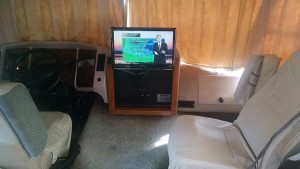 I’ve been asked many times how I was able to get my small table top 120 volt TV to work on the motor-homes 12 volts system..
I’ve been asked many times how I was able to get my small table top 120 volt TV to work on the motor-homes 12 volts system..
The correct answer is, I didn’t do anything. The TVs I used were designed to run on 12 volts DC, I just did some re-wiring to take advantage of it.
If you want to watch TV without running the generator or connected to shore power, the best option is to find a TV that can operate directly off of 12 volts DC. Many companies advertise and sell 12 volt TVs, but these never seem to be “just what I wanted” and the prices are usually higher than their corresponding 120 volt version.
However, if you know what to look for and what to do, you’ll discover that many “120 volt” TVs are actually designed to run on 12 volts, but aren’t sold or advertised as such. You can find these if you know what to look for.
Finding a 120 volt TV that will run on 12 volts.
Follow the TV power cord. If the one end of the TV power cord plugs into the wall outlet and the other end plugs into the back of the TV, this TV won’t work on 12 volts.
HOWEVER, if the power cord plugs into the wall outlet and then plugs into a small power supply box (shown on left). Or, if the TV uses one of those power supply things that plug directly into the wall outlet (shown on right), then we might be able to run this TV directly off of 12 volts.
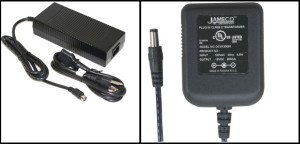
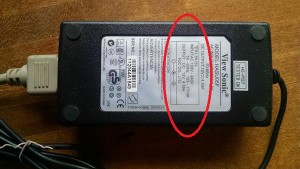
Look on the module, they usually list the input and output voltage. Your looking specifically for one that has an output voltage between 12-14 volts DC. The 12 volt DC are very common.
So you got the TV, now what.
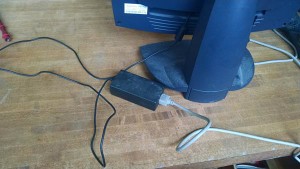
1) Plug the TV into a wall outlet, make sure it works, receives channels, etc. You want to make sure the TV works OK before you start cutting things. Once you make that cut, your warranty has also been cut.
2) Unplug the power supply connector from the TV, leave it plugged into the wall outlet. Use a volt meter and carefully measure the voltage and polarity on the end of the power supply connector. Normally, the center pin on the connector is PLUS and the outer sleeve is MINUS. But you MUST verify this.
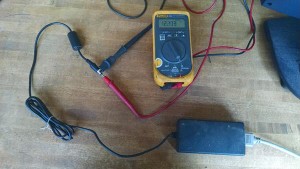
Correct polarity is crucial; is the center pin of the connector positive or negative. Read your meter, reverse the meter leads to verify that you see the polarity reverses. Most meters will show a “+” or “-” sign to indicate polarity.
Write down the polarity, better yet take a picture of your test so you know where the wires were and the voltage you read.
DO NOT cut the wire off of the power supply until you are absolutely, 100% positive as to the polarity of the connector that plugs into the TV.
3) Once you know the polarity, unplug the module from 120 volts.
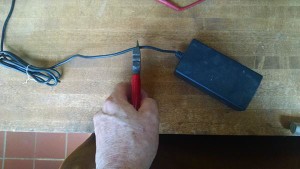
4) Cut the wire that comes out of the module and plugs into the TV. Cut it about 6 inches from the module, that way you can always hook the module back up, if you want to.
In the next few steps we are going to find out which wire is PLUS and which wire is MINUS.
5) Open up the ends of the wire you just cut and strip them leads back about 1/2 inch. Some modules will have two wires that can pull apart (zip cord), some will have a wire similar to coax cable.
6) Using your 12 volt battery, or 12 volt circuit that you plan on using for the TV. Splice the positive and ground battery wires to the correct TV power supply cable wires.
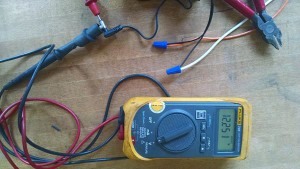
7) Reconnect your meter to the plug on the end of the TV power cable and check voltage and polarity. You should see between 12.5 – 14.5 volts, depending on your battery.
IMPORTANT – You should see the same polarity on your meter as you did in step #2. If not, you need to reverse the splice connections.
WARNING – IF YOU HOOK UP THE WRONG POLARITY – YOU WILL DESTROY YOUR TV.
Double, triple check the polarity on the plug with your meter.
Solder, wire nut, or butt splices the wires, re-verify polarity with the meter.
Once your satisfied that polarity is correct on the TV power cable, its time to plug it into the back of the TV and verify it works on battery.
Phantom Loads
Phantom loads is the name used to describe electrical items that draw a small amount of power, even when they are turned off. We usually ignore these loads in our homes, but in a battery operated environment, these loads can kill a battery in a few weeks.
Odds are good your 12 volt TV will have a phantom load on the battery when its not turned on. There are several ways to deal with this, If your motor-home has a USE / STORE feature, make sure the TV gets its power from the circuits that are turned off when you are in the STORE mode.
My Mirada doesn’t have this, so I installed a Phantom Loads switch that I use to remove power from radios, TVs,, etc.
You can read about my switch HERE

